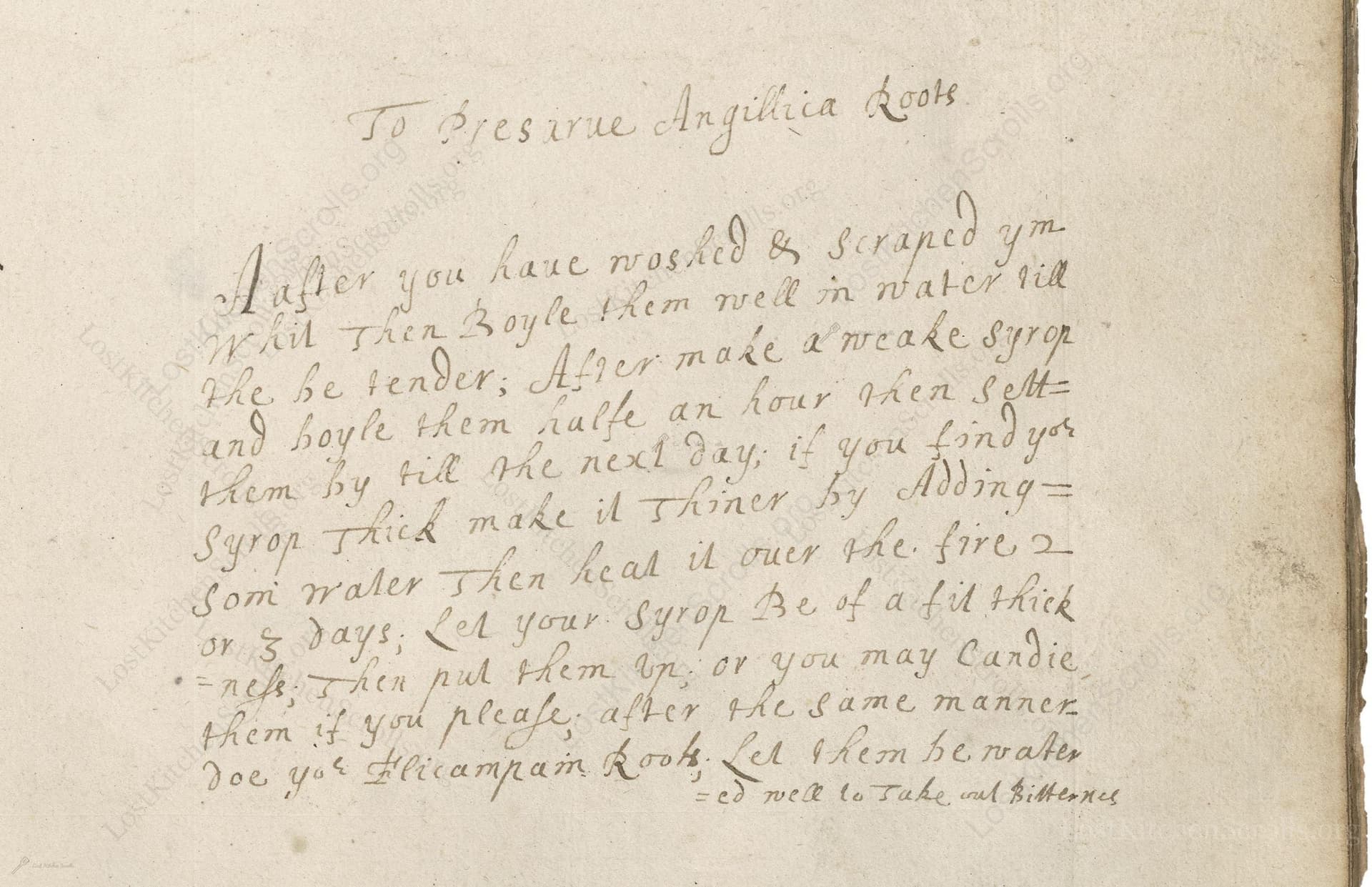To Preserue Angillica Roots
From the treasured pages of Cookbook of Susanna Packe
Written by Susanna Packe

To Preserue Angillica Roots
"After you have woshed & scraped ym well then boyle them well in water till the be tender; After make a weake syrop and boyle them halfe an hour then sett= them by till the next day; if you find yor syrop thick make it thiner by Adding= som water then heat it ouer the fire 2 or 3 days; Let your syrop be of a fit thick =nes, then put them in, or you may Candie them if you please; after the same manner doe yor Elicampain Roots let them be water =ed well to take out bitternes"
Note on the Original Text
The recipe employs characteristic 17th-century English spelling and syntax: 'preserue' for 'preserve', 'boyle' for 'boil', and idiosyncratic punctuation like equal signs to indicate line breaks. Directions are succinct, assuming the reader's familiarity with preservation techniques, and quantities are rarely specified, reflecting the more intuitive, experience-based cooking of the period. Spelling such as 'Angillica' (angelica), 'woshed' (washed), and 'Elicampain' (elecampane) are typical of this time before standardized English spelling.

Title
Cookbook of Susanna Packe (1674)
You can also click the book image above to peruse the original tome
Writer
Susanna Packe
Era
1674
Publisher
Unknown
Background
A delightful culinary treasure from the 17th century, this book offers a charming glimpse into the flavors and techniques that graced English kitchens in Susanna Packe's time, promising a feast of history and taste for any food enthusiast.
Kindly made available by
Folger Shakespeare Library
This recipe comes from Susanna Packe's collection, dating to 1674—a period characterized by a blossoming interest in preserving botanicals for both medicinal and culinary uses in England. Angelica and elecampane roots were valued for their aromatic and digestive qualities. Home cooks would often preserve the bounty of their kitchen gardens using sugar, a prized and increasingly accessible commodity in the 17th century. Recipes like this were both a practical method of food preservation and a sign of gentility and domestic accomplishment, often shared among the literate elite through handwritten recipe books passed down through families.

This recipe would have been made in a well-stocked early modern English kitchen. The cook would use iron or brass saucepans or cauldrons set over a wood or coal-fired hearth for boiling both the roots and the syrup. A sharp knife would scrape and cut the roots, while wooden spoons or paddles would stir the syrup. Strainers made from cloth or mesh would help remove roots from their boiling water or syrup. Jars made from glass or glazed pottery, often sealed with cloth and parchment, would serve as vessels for the final preserved product.
Prep Time
20 mins
Cook Time
2 hrs
Servings
8
We've done our best to adapt this historical recipe for modern kitchens, but some details may still need refinement. We warmly welcome feedback from fellow cooks and culinary historians — your insights support the entire community!
Ingredients
- 1 lb fresh angelica roots (or elecampane roots as a substitute)
- 1 cup white sugar
- 2 cups water (additional water for boiling and adjusting syrup)
- Optional: extra sugar for candying
Instructions
- Begin by thoroughly washing and peeling fresh angelica roots.
- Slice them into manageable pieces.
- Place the roots in a saucepan, cover with water, and bring to a gentle boil.
- Let them cook until they become tender—this should take about 20-30 minutes.
- Next, prepare a weak syrup by dissolving about 1 cup of sugar in 2 cups of water over low heat.
- Once the sugar has fully dissolved, add the drained angelica roots to the syrup and simmer for 30 minutes.
- Remove from heat and let the mixture sit overnight.
- On the following day, if the syrup has thickened too much, adjust by adding a little more water and heating gently.
- Repeat the simmering process for 2 to 3 days, allowing the roots to soak, cool, and then reheat in the syrup each time.
- Once the syrup reaches a thick, glossy consistency that coats the roots, transfer the syrupy roots to sterilized jars or proceed to candy them by draining and rolling in extra sugar.
- You can follow this same process for elecampane roots (Inula helenium), but ensure you soak and boil them longer to remove any bitterness, changing the boiling water as needed.
Estimated Calories
100 per serving
Cooking Estimates
Preparing and peeling the roots takes about 20 minutes. Cooking and simmering over several days adds up to around 2 hours of cooking time, not counting resting periods. This recipe yields about 8 servings, with roughly 100 calories per serving, mostly from sugar.
As noted above, we have made our best effort to translate and adapt this historical recipe for modern kitchens, taking into account ingredients nowadays, cooking techniques, measurements, and so on. However, historical recipes often contain assumptions that require interpretation.
We'd love for anyone to help improve these adaptations. Community contributions are highly welcome. If you have suggestions, corrections, or cooking tips based on your experience with this recipe, please share them below.
Join the Discussion
Rate This Recipe
Dietary Preference
Main Ingredients
Culinary Technique

Den Bockfisch In Einer Fleisch Suppen Zu Kochen
This recipe hails from a German manuscript cookbook compiled in 1696, a time whe...

Die Grieß Nudlen Zumachen
This recipe comes from a rather mysterious manuscript cookbook, penned anonymous...

Ein Boudain
This recipe comes from an anonymous German-language manuscript cookbook from 169...

Ein Gesaltzen Citroni
This recipe, dating from 1696, comes from an extensive anonymous German cookbook...
Browse our complete collection of time-honored recipes



